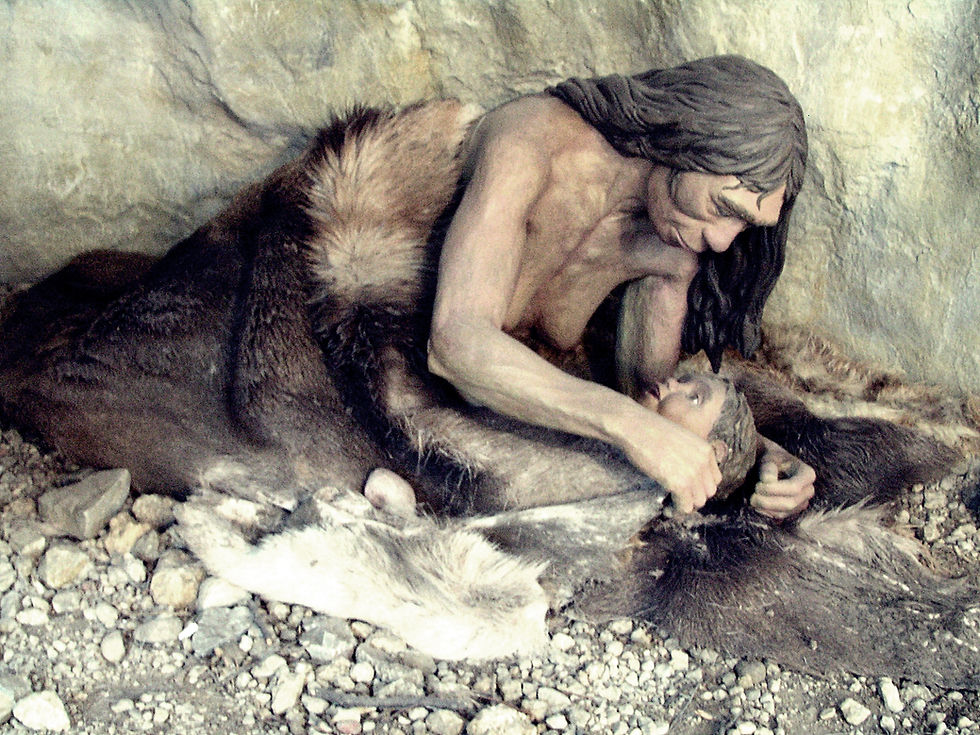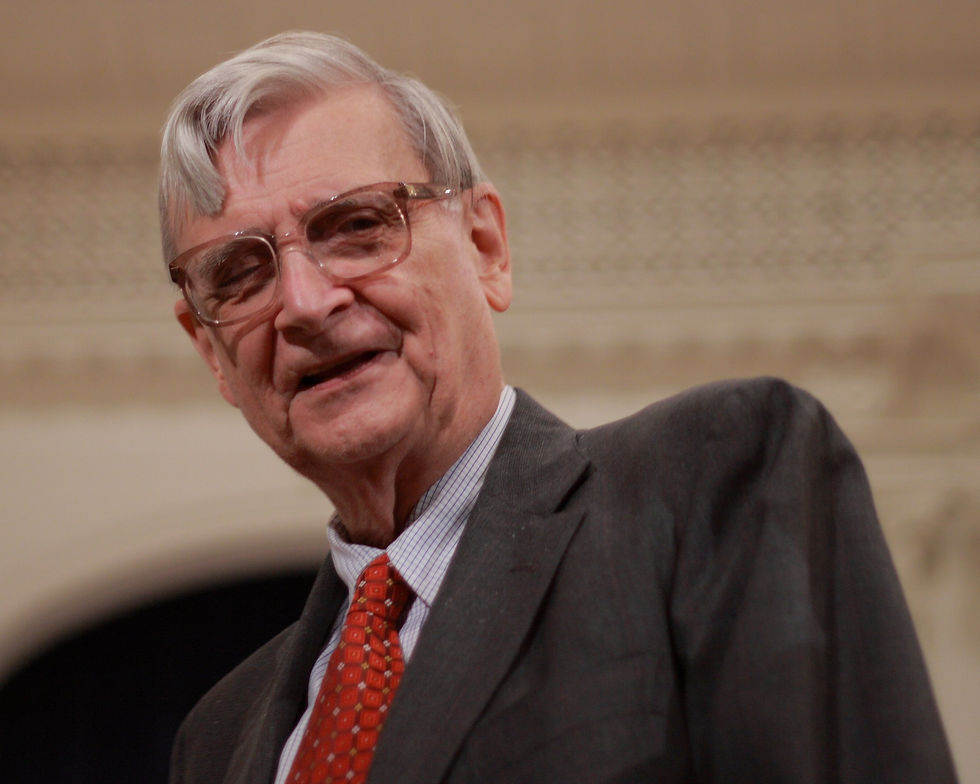Hominins and Homo: Evolutionary Preadaptations / Homíninos y Homo: preadaptaciones evolutivas
- jijorquera
- Jul 29, 2022
- 5 min read
Updated: Jan 18, 2025

Recreation of neanderthal mother and son / Figuras de madre e hijo neandertales
A sound out of time fills the cave: not the soughing and sighing of waves, for the sea fled as the cold bit and the mountains grimaced against icy armour. Now rough walls surround a soft ebbing breath, chasing a slowing pulse. At the end of the world, literally and figuratively, the last Neanderthal in Iberia witnesses a low, glinting sun across the distant Mediterranean. As a flint-dark sky lightens to grey dawn, soft coos of rock doves clash with the keening of lost gulls, crying like hungry children. But there are no more babies, no more of the people left, no one at all to join in watching the stars disappear; to hold vigil until the last breath leaves the air to cool.
Some forty thousand years later, oceans have risen again, salt tinges the air, and the walls of the same cave are ringing to voices and music – a requiem for a dream of the ancestors.
—Rebecca Wragg Sykes (1)

Edward Osborne Wilson
Edward Osborne Wilson, an American biologist and naturalist, pioneered evolutionary explanations of human behavior in his book Sociobiology, published in 1975. He identified pre-adaptations critical to the emergence of our species (2):
- We are terrestrial animals. (Aquatic animals cannot modify their environment significantly nor develop industry due to no access to fire.)
- We have a size suitable to allow a large brain.
- Our prehensile hands enable us to grip tools firmly. This characteristic is associated with the ability to walk upright (bipedalism), which permits the use of hands in other tasks while walking. The ability to use tools provokes intellectual development associated with their design, manufacture, use, and improvement.
- We usually consume meat, which provides us with enough energy.
- To obtain meat from carcasses left by other predators or from hunting, among other tasks to survive—our species formed stable cooperative social groups. Sociability requires higher intelligence, greater collaboration skills, and development of strategies to achieve common objectives. These groups likely increased their population to improve survival chances. United we stand....
However, we share these characteristics to some extent with other primates, such as chimpanzees and bonobos, and many of these traits are also found in extinct Hominin species. Hominins are Hominid primates characterized by the ability to hold an upright posture and practice bipedal locomotion.
However, the use of arms and hands was obviously much more skilled in the other extinct human species from our genus Homo and in the rest of Hominins than in chimpanzees or bonobos. No other primate has been able to develop the sophisticated tools that Hominins could manufacture with their bare hands, such as weapons (3).
Two final pre-adaptations are specific to the genus Homo and might be partially possessed by other pre-humans:
- We can control fire. Homo sapiens and other human species have been able to do so, let alone for about a million years.
- Our ancestors established stable camps, comparable to the nests of other social species, at least since Homo ergaster (also called H. erectus in Asia), and coinciding with the initial use of fire. With camps came division of labor and the consolidation of hierarchies such as those already present in other primates.
I will add more posts about the hominins and the other extinct Homo species, the missing humans.
Versión en español:
Un sonido intemporal llena la cueva: no el susurro y el suspiro de las olas, porque el mar huyó mientras el frío y las montañas hacían muecas contra una armadura helada. Ahora las paredes ásperas rodean una suave respiración menguante, persiguiendo un pulso cada vez más lento. En el fin del mundo, literal y figurativamente, el último neandertal en Iberia es testigo de un sol bajo y brillante a través del lejano Mediterráneo. A medida que un cielo oscuro como el pedernal se ilumina hasta un amanecer gris, suaves arrullos de palomas chocan con el entusiasmo de las gaviotas perdidas, llorando como niños hambrientos. Pero no quedan más bebés, no queda más gente, nadie que se una a ver desaparecer las estrellas; para mantener la vigilia hasta que el último aliento deje que el aire se enfríe.
Unos cuarenta mil años después, los océanos se han levantado de nuevo, la sal tiñe el aire y las paredes de la misma cueva suenan a voces y música, un réquiem por un sueño de los antepasados.
—Rebecca Wragg Sykes (1)
Edward Osborne Wilson, un biólogo y naturalista estadounidense, fue pionero en las explicaciones evolutivas del comportamiento humano en su libro Sociobiología, publicado en 1975. Identificó varias preadaptaciones críticas para la aparición de nuestra especie (2):
- Somos un animal terrestre. Los animales acuáticos no pueden modificar significativamente su entorno ni desarrollar la industria debido a la falta de acceso al fuego.
- Tenemos un tamaño adecuado para permitir un cerebro grande.
- Estamos equipados con manos prensiles, lo que nos permite utilizar herramientas que podemos agarrar con firmeza. Esta característica se asocia con la capacidad de caminar erguido (bipedalismo), que permite el uso de las manos en otras tareas mientras se camina. La capacidad de usar herramientas provoca el desarrollo intelectual asociado con su diseño, fabricación, uso y mejora.
- Solemos consumir carne, lo que nos proporciona suficiente energía.
- Para obtener carne de la caza o de despojos dejados por otros depredadores, entre otras tareas para necesarias para sobrevivir, nuestra especie formó grupos sociales cooperativos estables. La sociabilidad requiere una mayor inteligencia, mayores habilidades de colaboración y el desarrollo de estrategias para lograr objetivos comunes. Estos grupos, para aumentar sus posibilidades de supervivencia, probablemente tendían a crecer en población. La unión hace la fuerza....
Hasta ahora, estas características también son poseídas, en parte, por otros primates, principalmente por chimpancés y bonobos. La mayoría de estos rasgos también se comparten con especies extintas de homíninos. Los homíninos son primates homínidos caracterizados por la capacidad de mantener una postura erguida y practicar la locomoción bípeda.
Sin embargo, el uso de brazos y manos era obviamente mucho más hábil en las otras especies humanas extintas de nuestro género Homo y en el resto de homíninos que en chimpancés o bonobos. Ningún otro primate ha sido capaz de desarrollar las sofisticadas herramientas que los homíninos podrían fabricar con sus propias manos, como las armas (3).
Estas dos preadaptaciones finales son específicas del género Homo y podrían ser parcialmente poseídas por otros prehumanos:
- Podemos controlar el fuego. Homo sapiens y otras especies humanas han sido capaces de hacerlo, y mucho menos durante aproximadamente un millón de años.
- Nuestros antepasados establecieron campamentos estables, comparables a los nidos de otras especies sociales, al menos desde el Homo ergaster (también llamado H. erectus en Asia), y coincidiendo con el uso inicial del fuego. Con los campamentos llegó la división del trabajo y la consolidación de jerarquías como las ya presentes en otros primates.
Agregaré más publicaciones sobre los homínidos y las otras especies extinguidas de nuestro género Homo, los humanos ausentes.
Images / Imágenes:
Recreation of neanderthal mother and son / Figuras de madre e hijo neandertales. Author / Autor: Jaroslav A. Polák from Brno, Czech Republic.https://commons.wikimedia.org/wiki/File:Brno,_Neanderthal_Mother_(detail_of_diorama).jpg. CC0, via Wikimedia Commons.
Edward Osborne Wilson. Author / Autor: Ragesoss. https://commons.wikimedia.org/wiki/File:E._O._Wilson_looking_down,_October_16,_2007.jpg. CC BY-SA 3.0 <https://creativecommons.org/licenses/by-sa/3.0>, via Wikimedia Commons.
References / Referencias:
1. Rebecca Wragg Sykes. Kindred: Neandertal Life, Love, Death and Art. Bloomsbury Sigma, London, 2020.
2. Edward O. Wilson. Sociobiology: The New Synthesis, 1975, Harvard University Press, Cambridge, MA, Twenty-fifth Anniversary Edition, 2000.
3. Edward O. Wilson. The Social Conquest of Earth. Liveright Publishing Corporation, New York, 2012.






Comments